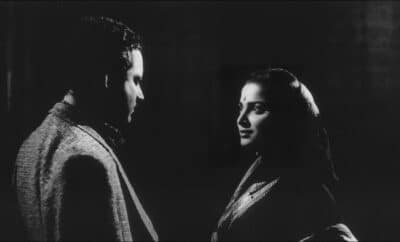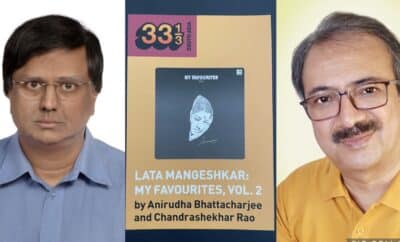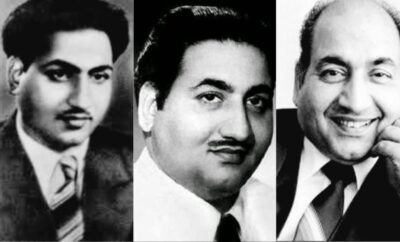Collections
Sajjad – The Contentious Master of Melodies
Some artists are blessed with enormous talent and at the same time, cursed with inability to encash it. He was one such artist. He could play 15 odd musical instruments proficiently. He was the master of offbeat tunes, which even the best of singers of his times found challenging. Many of his compeers highly and openly appreciated his extraordinary compositions. He was well aware of his talent and perhaps that’s why, full of conceit. He could simply not bear with injustice and cunningness. He was a man of no compromise. He was also a perfectionist and would not spare even a singer like Lata Mangeshkar if he was not satisfied with the rendition. To add to this, he was bestowed with short-tempered nature and a tongue like a sharp sword – play with his ego and he would surely shoot at you straight from the shoulder! It was like digging own grave in the plastic world of cinema full of swell-headed creatures, where ego massagers were valued more than the talented people. While a few artists respected his talent and took his attitude with a pinch of salt, quite a few others were rubbed the wrong way and his paths to success were blocked one by one. As a result, he could bag less than 20 films in his career spanning across 3 decades.
You guessed it right! The unfortunate composer was Sajjad Hussain. Born on 15 June 1917 in Sitamau, a village in Madhya Pradesh, Sajjad Hussain was taught sitar at an early age by his father. While juts in his teens, he could already play veena, violin, flute, piano and mandolin. He had astounding mastery over mandolin, so much so that he could play even Indian classical music on the conventionally non-classical instrument. He came to Mumbai (then Bombay) to try his luck in 1937. He worked as an assistant to several composers like Meer Saheb, Rafiq Ghaznavi, and Mir Allah Baksh (Meena Kumari’s father) and as a contract instrument player for producer-director Shaukat Hussain Rizvi. He composed two songs for Gaali (1944) as an assistant to the main composer Hanuman Prasad. The film Dost released in the same year was his first film as an independent composer. All the songs from the film, most of which were sung by Noorjahan, were big hits. However, Shaukat Hussain Rizvi, the producer of the film and Noorjahan’s husband gave the entire credit to his wife. Agitated with this, Sajjad Hussain vowed never to work with Noorjahan again; and a mellifluous combination of the two great artists that could have come into being ended with only one film.
He thereafter went on to work with many notable singers like Suraiya, Lata Mangeshkar, Asha Bhosle, Mohammed Rafi and Geeta Dutt. Lata Mangeshkar was his favourite singer. He was so fond of her singing skills that he is reported to have said – “Lata gaati hai, baki sab roti hain” (only Lata sings, other singers just cry under the garb of singing). Lata Mangeshkar also holds him in high reverence and has often named him as one of her favourite composers. The song “Aye dilruba, nazren mila” that she has sung under his baton for Rustam Sohrab (1963) finds place in her personal favourites. However, he was not quite happy with some singers like Talat Mahmood and Kishore Kumar. There is a hearsay that he used to call Talat Mahmood as “Ghalat Mahmood” and Kishore Kumar as “Shor Kumar”. However, he is seen to have worked with both these singers. One is therefore left in wonderment whether this is true. Once you are defamed, isn’t it easy for people to malign you? Simple as that!
Though he had a good sense of humour, he used to crack jokes with a deadpan, which would ofttimes lead to misunderstandings. Due to this and his habit of talking turkey, he invited conflicts with many other contemporary stalwarts like Dilip Kumar, producer-director K. Asif, producer S. Mukherjee and lyricist D.N. Madhok. People started avoiding and ignoring him. Consequently, his career, that was at its peak during the late 1940s and the early 1950s almost came to an end after the mid-1950s. He could get only one film in the 1960s and two in the 1970s.
One of the milestones of his career was the soundtrack that he composed for the Sri Lankan Sinhala film Daiwa Yoagaya (1959). Sajjad’s compositions contributed a lot the box office success of the film and the songs are popular in Sri Lanka to date.
Let us have a quick look at his repertoire, which, quantitatively howsoever brief, is qualitatively quite rich and remains unparalleled.
1. Koi Prem Ka Deke Sandesa (Dost – 1944)
Sajjad Hussain proved his mettle in this very first soundtrack. All the songs became very popular. Particularly, the Noorjahan solo “Badnam muhabbat kaun kare” became a rage. However, its popularity overshadowed other melodious songs in the album, like “Koi prem ka deke sandesa”, another Noorjahan solo. She had such an adorable style of rendition, that even the melancholic songs such as this sound sweet. Unfortunately, this was the first and the last film of Noorjahan and Sajjad together, and the music lovers were deprived of rich compositions of their combination forever.
The lyrics are written by Shams Lakhnavi.
2. Toot Gaya Haye Toot Gaya (Magroor – 1950)
The soundtrack of the film was composed by Sajjad Hussain, Bulo C. Rani and Ram Punjwani. Though there is no account of which composer composed which song, the song “Toot gaya haye toot gaya” has the typical Sajjad stamp all over, right from the prelude till the brief concluding aalap. The pathos-laden composition is rendered by Mohammed Rafi, Rajkumari and Shamshad Begum; and is picturised on Rehman, Meena Kumari and Nigar Sultana. The lyrics are penned by Mullaji.
Sajjad’s hallmark coupled with superb rendition by the three singers makes this song an aural treat.
3. Bhool Ja Aye Dil Muhabbat Ka Fasana (Khel – 1950)
The film starred Dev Anand, Nigar Sultana and Nargis in the lead roles. The soundtrack composed by Sajjad has 9 songs sung by various singers, including 2 solos by Lata Mangeshkar. This is the first released joint work of Sajjad Hussain and Lata Mangeshkar, though this is not their first joint work. One of the Lata solos, “Bhool ja aye dil muhabbat ka fasana” is a brilliant composition, full of Sajjad’s typical modulations testing the singer to the core. This was one of Sajjad’s personal favourites. The lyrics of the song are penned by Shams Azimabadi.
Lata Mangeshkar has carried this arduous composition adeptly on her young shoulders. No wonder, she went on to become his favourite singer! You cannot but fall in love with this poignant yet catchy composition.
4. Aaj Mere Naseeb Ne Mujhko Rula Rula Diya (Hulchul – 1951)
Dilip Kumar and Nargis played the lead roles in the film. Some songs from the film are composed by Sajjad Hussain and some by Mohammed Shafi, with the lyrics written by Khumar Barabankvi.
Sajjad Hussain happened to meet the renowned classical vocalist Amanat Khan Devaswale, who praised one of his disciples a lot during the discussion with Sajjad. Knowing how difficult it was to get compliments from Khan saheb, he was impressed with his yet unseen disciple and decided to test her. In due course, he recorded a song with the disciple. The disciple was none other than Lata Mangeshkar and the song was “Aaj mere naseeb ne mujhko rula rula diya” for the film Hulchul. However, the film was released with some delay, and as such, Khel (1950) became their first released joint work.
This is yet another testing composition in Sajjad’s usual style, which Lata Mangeshkar has rendered skilfully even at that young age. The song is filmed on Nargis, who is lamenting her heartbreak.
5. Kali Kali Raat Re, Dil Bada Sataye (Saiyan – 1951)
The film, inspired from the Hollywood film “Duel in the Sun (1946)”, had Madhubala, Ajit and Sajjan in the lead roles. The soundtrack has several euphonious songs, one better than the other, composed by Sajjad. All the songs except 2 are sung by Lata Mangeshkar.
The songs were written by Rajendra Krishan, D.N. Madhok and Hasrat Jaipuri. D.N. Madhok had the habit of presenting the lyrics to the composers in the tune composed by himself. While many composers were happy with this as they got a readymade tune, someone like Sajjad certainly could not entertain this. He said to the producer in his usual sarcastic style that if D.N. Madhok was going to compose tunes, Sajjad would be the lyricist. He then asked Madhok to compose tunes for all his lyrics and proposed that if his tunes were better than those of Sajjad’s, he would let Madhok’s tunes be used. However, after listening to Sajjad’s tunes, Madhok accepted his supremacy in all fairness and Sajjad remained the composer of the soundtrack.
The brilliantly composed sad song “Kali kali raat re, dil bada sataye”, penned by D.N. Madhok and filmed on Madhubala, is sung by Lata Mangeshkar in a voice drenched in pathos.
6. Ye Hawa, Ye Raat, Ye Chandni (Sangdil – 1952)
Sangdil had Dilip Kumar and Madhubala as the protagonists. The film’s soundtrack is one of Sajjad’s masterpieces. The lyrics were written by the eminent lyricist Rajendra Krishan, who had equal mastery over Hindi and Urdu.
The song “Ye hawa, ye raat, ye chandni” sung by Talat Mahmood is an epitome of romance. Sajjad’s lovely composition adorned with sitar, sarangi and tabla, Rajendra Krishan’s Urdu dominated lyrics, Talat Mahmood’s velvety rendition and handsome Dilip Kumar and beautiful Madhubala on screen make this song an audio-visual treat. It is said that Sajjad made Talat Mahmood rehearse the song several times before recording, to make sure that Talat delivered what he wanted; and the song was finalised after 16 retakes.
There is an interesting story about this song, which many of us know. Madan Mohan was so impressed with this composition, that he later composed a song on a similar tune – “Tujhe kya sunaoon main dilruba” sung by Mohammed Rafi for Aakhri Dao (1958). When confronted by Sajjad on plagiarism, Madan Mohan tactfully replied, “I could not find any better music director to copy.” This rendered Sajjad speechless. Such was the charisma of Sajjad’s compositions.
The soundtrack has also two other memorable songs – the Lata – Talat romantic duet “Dil mein sama gaye sajan” and the melancholic Lata solo “Wo to chale gaye aye dil”.
7. Tere Jahaan Se Chal Diye (Rukhsana – 1955)
The film starred Kishore Kumar and Meena Kumari in the main roles. Unlike Sajjad’s previous soundtracks in the 1950s, this is an Asha dominated soundtrack and Lata Mangeshkar has sung only one song. Another noteworthy feature of the soundtrack is the presence of Kishore Kumar, who was supposed to be one of the singers loathed by Sajjad. Sajjad would have probably worked with Kishore Kumar, because Kishore Kumar himself was playing the lead role. Interestingly, Kishore Kumar finds place only in two songs, both of which are duets with Asha Bhosle.
The Asha – Kishore duet “Tere jahaan se chal diye” is a touching song written by Khumar Barabankvi and composed by Sajjad in his unique style.
The song also has another version, which is an Asha solo.
8. Ye Kaisi Ajab Dastaan Ho Gayi Hai (Rustam Sohrab – 1963)
The film, based on the legendary poem of Rustam and Sohrab by the Persian poet Ferdowsi, had Suraiya and Prithviraj Kapoor in the lead roles. The soundtrack was a chef-d’oeuvre composed by Sajjad Hussain after a gap of almost 8 years. He showed through his compositions that he hadn’t lost even a tad bit of his musical acumen, though the film industry had written him off. His compositions perfectly suit the Persian background of the film. However, he again disappeared from the landscape of Hindi cinema after this film until the 1970s, when he did his last two films.
It was Suraiya’s last film. She gave up her acting and singing career completely after this. The soundtrack has her swan song “Ye kaisi ajab dastaan ho gayi hai”, sung by as well as filmed on her. This is one of Sajjad’s top notch compositions and Suraiya’s greatest hits. The words are written by Qamar Jalalabadi.
Sajjad’s haunting composition and Suraiya’s beautiful rendition coupled with her impressive acting mainly through her expressive eyes have rendered this song immortal.
The film also has another masterpiece rendered by Lata Mangeshkar – “Aye dilruba, nazren mila”.
9. Teri Mehfil Mein Aaye Hain (Mera Shikar – 1973)
The film seems to be a B-grade film starring Dara Singh and Amita in the lead roles. The soundtrack composed by Sajjad has only 3 songs, which are sung by Mohammed Rafi, Asha Bhosle and Usha Mangeshkar. The words are written by Shakeel Nomani.
The Rafi solo “Teri mehfil mein aaye hain” is a nice song composed in qawwali style. Mohammed Rafi has sung it wholeheartedly bringing out all the nuances as always.
10. Kisi Se Mili Hai Nazar Beiraada (Aakhri Sajda – 1977)
This was Sajjad’s last film as a composer. What a strange coincidence that his last film is named as Aakhri Sajda (the last prayer)! The songs from the film are sung by Usha Mangeshkar and Mohammed Rafi.
The Usha solo “Kisi se mili hai nazar beiraada” is a fantastic composition with Sajjad’s inimitable touches.
https://www.youtube.com/watch?v=YraqDZJeDNk
Sajjad Hussain once said in a radio interview, “I always composed extraordinary songs. Though many of my songs did not become popular, they were not ordinary.” Howsoever boastful his statement may sound, isn’t it proven right by the songs that we just glanced through? But alas, retirement was imposed on this master of extraordinary compositions; and as fate would have it, he had to spend his last days in obscurity and poverty, curtailing his outspokenness in order to make sure that his sons working as mandolin players for other composers didn’t lose their job.
The contentious master of melodies would nonetheless eternally rule the hearts of music aficionados!



